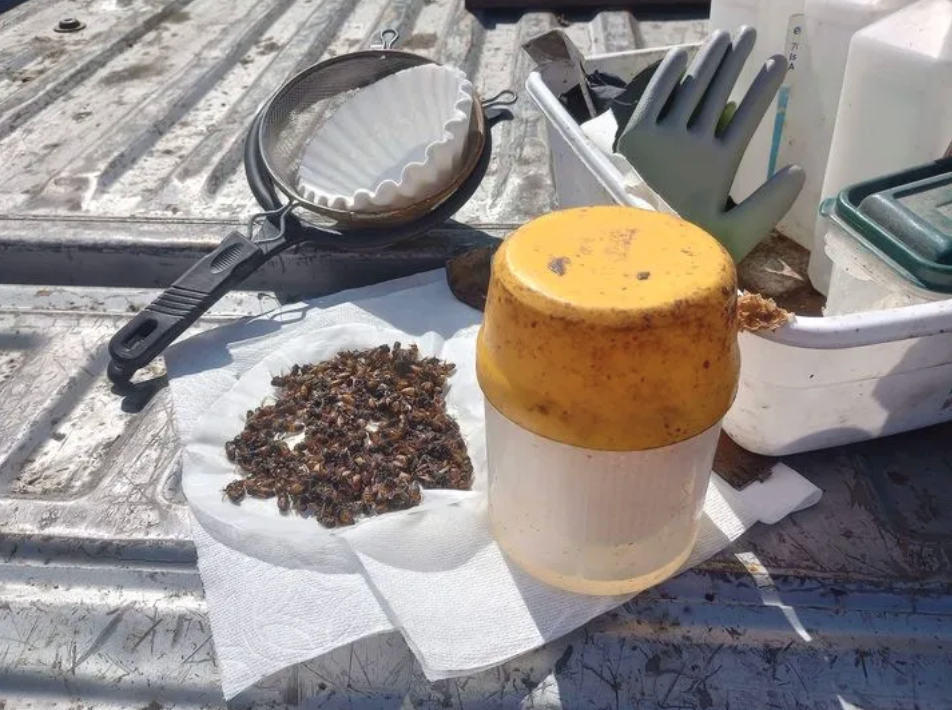
Varroa mites - get comfortable and be prepared
Share
It's that time again in our beekeeping year to physically deal with Varroa mites (Varroa destructor), the parasitic scourge of all bee hives. These little pests bite into the bees, cling to them like ticks, and then feed off their fat stores while transferring viruses and diseases. They live in harmony with the Asian honeybee but crossed to the European honeybees and eventually made their way to the US, which has never had to deal with them. Without intervention, a new hive can quickly become very sick and die off within 1-2 years. Since the introduction of mites to our area, the focus has been on research and testing of both treatment options and honeybee genetics in the hopes that a solution is found to this horrible situation.
In the meantime, we, as beekeepers, have a responsibility to help our honeybees stay healthy. Coming out of the dearth and the horrible heat wave that hit our area, I'm now focusing on testing and treating mites. My mite levels are not as high as I would typically find, which is excellent, but some out yards need to be treated. I test every outyard with the alcohol wash method. Yes, this takes time and kills 300 nurse bees for each test completed, but I feel it is necessary to help all of the hives in the area to remain healthy. I test and treat 2-4 times a year, and I rotate through mite treatments that work within the current temperature and environment limits. I get help to figure this out by utilizing the information on the honeybeehealthcoalition.org website. They have an excellent Varroa Management Guide with thresholds for all seasons, plus accurate, descriptive information on all mite treatments currently approved and on the market. The guide also focuses on management options to try to keep from having to utilize chemicals and acids in the hive. But, sometimes, these options don't always work, and you have to treat, so be prepared. Their interactive tool is easy to use and helps to find a mite treatment quickly. If you are a beekeeper, I urge you to visit their website.
I remember when I first started beekeeping and how intimidated I felt when testing and then having to treat for mites, so I devised a way to keep myself organized, which helped to keep my anxiety at bay. At the same time, I got comfortable with this part of beekeeping. I created a mite treatment "tub," which includes a white tall-sided tub, easy check mite wash container, alcohol, gloves, queen clip, coffee filters, and handheld strainer. I place all the items in the tub when not in use and store them on a shelf in my bee equipment area of my shop, where it is always available to grab and go as needed. The second part is ensuring I always have available spring and fall mite treatment options. Nothing is worst than testing for mites and finding out treatment is needed and being delayed by shopping/delivery. Also, mite treatment options sell out quickly with the larger bee supply companies due to expiration dates (no company wants to lose money with expired goods), so I always plan ahead and order early. Like all beekeepers, I have personal opinions regarding treatment options, and I choose to not use synthetic treatments and stick mainly to organic acid treatments. However, both are highly caustic to the bees and require protective gear to be worn during application. Finally, I calculate mite thresholds before I head out to test and write them down on a cheat sheet to quickly determine if treatment is needed.
As you can probably figure out, dealing with Varroa mites is a time-consuming process and can get expensive based on how many hives you have, and sometimes it takes beekeepers 1-2 years to get fully onboard with the whole process. What I say to all beekeepers, until they figure out exactly how to eradicate mites from our hives, we have a responsibility to help the bees stay healthy by following the Varroa mite management guidelines outlined on the Honey Bee Health Coalition website, which are specifically created to help keep them under control.
